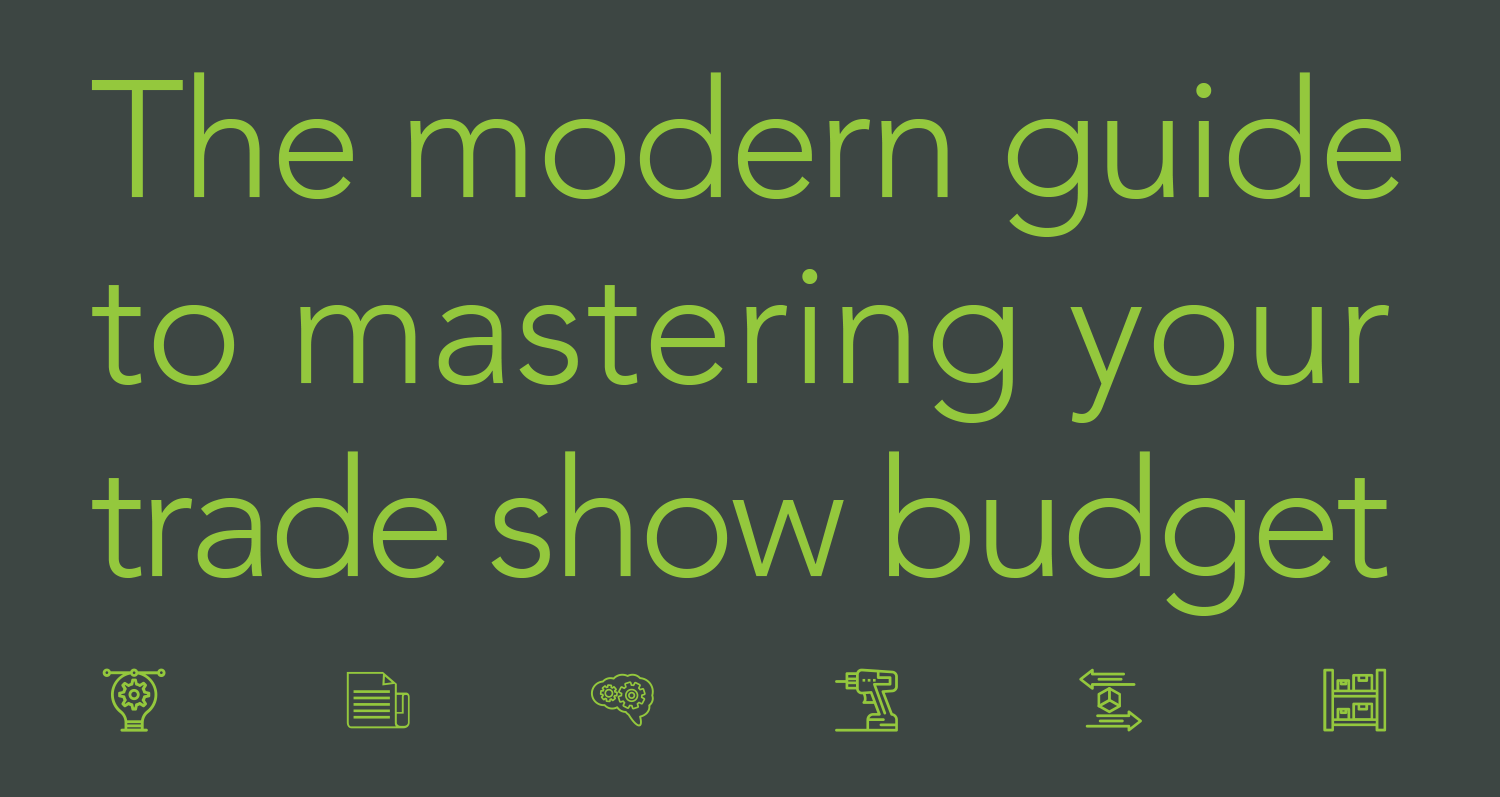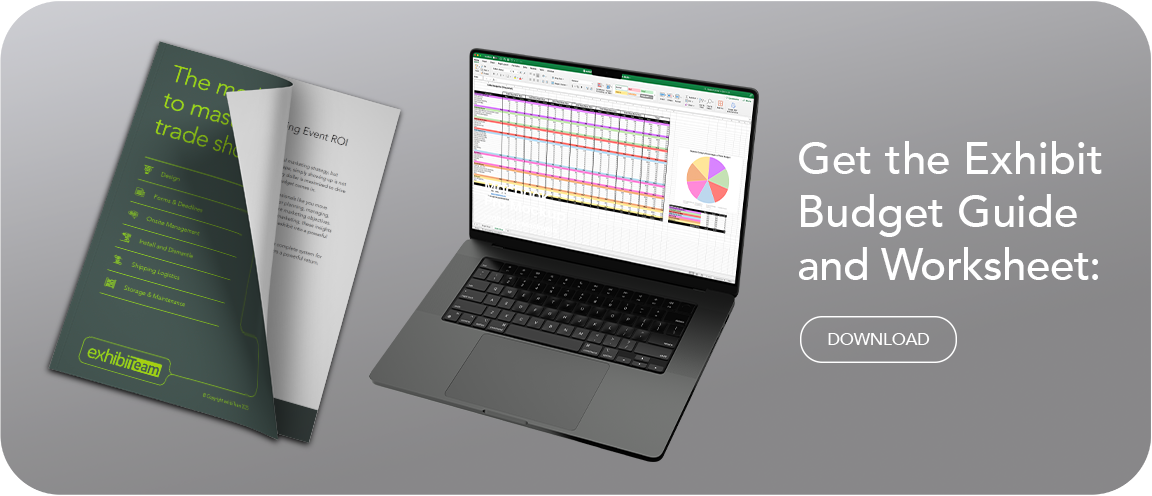
Your Strategy for Maximizing Event ROI
Introduction
Trade shows remain a powerful component of a successful marketing strategy, but their complexity has grown. In today’s competitive landscape, simply showing up is not enough. Success requires a strategic approach where every dollar is maximized to drive measurable results. That’s where a meticulously planned budget comes in.
This guide was developed to help modern marketing professionals like you move beyond simple expense tracking. It’s a strategic framework for planning, managing, and optimizing your trade show budget to align with your core marketing objectives. Whether you’re a seasoned pro or new to the world of event marketing, these insights will help you navigate the financial complexities and turn your exhibit into a powerful engine for growth.
Paired with our Exhibit Budget Worksheet, this guide provides a complete system for keeping your costs in check and ensuring your investment delivers a powerful return.
Step 1: Align Your Budget with Your Goals
Before you can allocate a single dollar, you must define what success looks like. Your trade show budget is not just a list of expenses; it’s a financial plan designed to achieve specific business outcomes. Start by answering these fundamental questions:
- What is our primary objective? Are you focused on generating qualified leads, launching a new product, increasing brand awareness, or nurturing customer relationships? Your main goal will dictate where you invest the most.
- What size and type of presence do we need? The scale of your exhibit should directly support your goals. A 10’x10′ inline space has a very different cost structure and potential impact than a 30’x30′ island booth with live demonstrations.
- Who is our target audience? Understanding the attendees you want to attract will inform your messaging, your booth experience, and your promotional activities.
- How will we measure success? Define your Key Performance Indicators (KPIs) from the start. This could be the number of qualified leads, cost per lead, meetings booked, or social media engagement.
Answering these questions first ensures your budget is a strategic tool, not just an accounting exercise.
Step 2: Build Your Initial Budget Estimate
Every trade show budget is built around six core expense categories. These align directly with the sections in our Exhibit Budget Worksheet, creating a seamless planning experience.
- Show Management/Booth Space: The cost to rent your physical space on the show floor.
- Exhibit/Display Related: The design, fabrication, and technology for your booth itself.
- Display Set-up & Tear-down: The labor required to install and dismantle your exhibit.
- Exhibit Show-site Services: The essential services needed to make your booth function.
- Booth Staffing: The costs associated with having your team on-site.
- Promotion/Marketing: The activities to drive traffic and engagement before, during, and after the show.
Your situation will influence the initial estimate. Are you using an existing display, renting an exhibit, or investing in a brand-new build? Each path has a different financial impact. A rental, for example, might have a higher per-show cost but eliminates expenses related to storage, refurbishment, and long-term ownership.
Step 3: A Detailed Breakdown of Core Budget Categories
This is where you move from an estimate to a detailed, line-item budget. Use the Exhibit Budget Worksheet to track your planned vs. actual spending in each of these areas.
1. Show Management/Booth Space
This is more than just the square footage. Consider all costs paid directly to the show organizers.
- Booth Space Rental: Often the largest single expense. Plan this for your entire show calendar to potentially leverage multi-show discounts.
- Show Sponsorships & Advertising: Opportunities to increase visibility through the show’s official channels. Evaluate these based on their potential to reach your target audience.
- Registration Badges: Account for the cost of exhibitor badges for your entire team.
2. Exhibit/Display Related
This category covers the heart of your presence: the booth itself.
- Design & Fabrication: Whether you are purchasing, renting, or refurbishing an existing property. Modern exhibits often use lightweight, sustainable materials that can reduce shipping and drayage costs over the long term.
- Graphics: High-quality graphics are essential for communicating your brand message. Budget for refreshing graphics annually to keep your look current.
- In-Booth Technology: Interactive touchscreens, video walls, virtual reality demos, and charging stations can significantly increase engagement but come with specific costs for hardware and content creation.
3. Display Set-up & Tear-down (I&D)
Professional labor is often required for installation and dismantle.
- I&D Labor: Costs are typically based on hourly rates that can vary significantly by city and whether work occurs during straight time, overtime, or double time.
- Pro Tip: Read the show manual carefully to understand union rules. Simple tasks like unboxing literature or setting up pop-up displays can sometimes be done by your own team, saving on labor costs. Always confirm what is and isn’t allowed.
4. Exhibit Show-site Services
These are the operational costs that can quickly add up if not managed carefully.
- Shipping & Drayage: Shipping gets your exhibit to the venue; drayage (or material handling) is the fee to move it from the loading dock to your booth space and back. Drayage is calculated by weight and can often exceed your shipping costs. Always ship in advance to the warehouse to get better rates.
- Electrical & Internet: These are essential utilities. Order them in advance to avoid costly on-site rates. A dedicated hard-wired internet connection is more reliable and often more secure than shared Wi-Fi.
- Lead Capture: Whether you rent the show’s device or use your own app-based system, this is a critical investment for tracking ROI.
- Other Services: This includes flooring, furniture rental, hanging sign rigging, and booth cleaning.
5. Booth Staffing
Your team is your most important asset. Plan for their success and well-being.
- Travel, Food & Lodging: Book flights and hotels well in advance to secure the best rates. Using the official show housing block can often provide savings and convenience.
- Staff Wages/Labor: Factor in the time your team is out of the office and dedicated to the show.
- Staff Attire: Branded apparel ensures a professional, cohesive look for your team.
6. Promotion/Marketing
A great booth is useless if no one knows you’re there.
- Pre-Show Promotion: Generate buzz with email marketing, targeted social media ads, and direct outreach to key prospects on the pre-registered attendee list (if available).
- In-Booth Engagement: Budget for product demos, presentations, or interactive experiences.
- Giveaways/Premiums: Choose items that are useful to your target audience and reinforce your brand message. Ordering for your entire year’s event schedule at once can significantly reduce the cost per unit.
Step 4: Track, Analyze, and Optimize
Your budget is a living document. The real power comes from using the Exhibit Budget Worksheet to track actual spending against your plan.
- Track Variances: The worksheet will automatically show you where you are over or under budget, allowing you to make real-time adjustments.
- Post-Show Analysis: After the event, conduct a thorough review. Where did you overspend? What costs were unexpected?
- Calculate Your ROI: Compare your total investment (the grand total from your worksheet) against the value of the leads generated, deals closed, or other KPIs you established in Step 1.
This analysis is invaluable. It transforms each show into a learning experience, making your budgeting process more accurate and effective for the next event.
Conclusion
Mastering your trade show budget is about making strategic choices that support your marketing goals. By planning meticulously, tracking expenses diligently, and analyzing your results, you can transform your trade show program from an expense into a high-performing investment.
Use this guide as your roadmap and our Exhibit Budget Worksheet as your compass. Together, they provide the structure and insight you need to exhibit with confidence and achieve remarkable success.
Ready to take control? Let’s build something great together.





